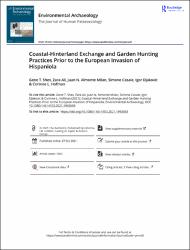Coastal-hinterland exchange and garden hunting practices prior to the European invasion of Hispaniola
| License | This is an Open Access article distributed under the terms of the Creative Commons Attribution-NonCommercial-NoDerivatives License, which permits non-commercial re-use, distribution, and reproduction in any medium, provided the original work is properly cited, and is not altered, transformed, or built upon in any way. | es |
| Author | Shev, Gene T. | |
| Author | Ali, Zara | |
| Author | Almonte Milan, Juan N. | |
| Author | Casale, Simone | |
| Author | Djakovic, Igor | |
| Author | Hofman, Corinne L. | |
| Accessioned date | 2023-05-03T23:58:16Z | |
| Available date | 2023-05-03T23:58:16Z | |
| Year | 2021 | |
| Citation | Shev, G. T., Ali, Z., Almonte Milan, J. N., Casale, S., Djakovic, I., & Hofman, C. L. (2021). Coastal-hinterland exchange and garden hunting practices prior to the European invasion of Hispaniola. Environmental Archaeology, 1-22. Recuperado de: | es |
| URI | https://bvearmb.do/handle/123456789/2727 | |
| Abstract | This study analyses zooarchaeological material recovered from the late precolumbian site of El Flaco (AD 990–1450), northern Dominican Republic. The faunal assemblage from this inland settlement demonstrates terrestrially focused modes of faunal exploitation but with some resources obtained from coastal ecosystems, such as mangrove forests, sandy-bottom, and reefs, which are located approximately 20 km to the northwest. This study establishes last occurrence dates for extinct taxa; examines the spatial distribution of fauna; explores modes of food procurement; and the effects of agricultural activities on local fauna by investigating animal remains from three excavation units. A diachronic study of animal remains from one artificial mound demonstrates changing patterns in resource exploitation, such as an increasing consumption of land crab over a roughly 100-year period. This study follows previous research that examined the isotope ecology of endemic species from El Flaco that indicates some hutias were possibly scavenging or being fed cultivated plants. | es |
| Language | English | es |
| Published | Environmental Archaeology, 1-22 | es |
| Rights | © 2021 The Author(s). Published by Informa UK Limited, trading as Taylor & Francis Group. | es |
| Rights URI | http://creativecommons.org/licenses/by-nc-nd/4.0/ | es |
| Subject | Biodiversidad - República Dominicana | es |
| Subject | Hábitats y especies | es |
| Subject | Arqueología ─ República Dominicana | es |
| Subject | Ecología | es |
| Title | Coastal-hinterland exchange and garden hunting practices prior to the European invasion of Hispaniola | es |
| dc.identifier.doi | https://doi.org/10.1080/14614103.2021.1993693 | |
| Material type | Article | es |
| Type of content | Scientific research | es |
| Access | Open | es |
| Audience | Technicians, professionals and scientists | es |
Files in this item
This item appears in the following Collection(s)
-
Investigación ambiental [1743]
Access and downloading this document are subject to this license: This is an Open Access article distributed under the terms of the Creative Commons Attribution-NonCommercial-NoDerivatives License, which permits non-commercial re-use, distribution, and reproduction in any medium, provided the original work is properly cited, and is not altered, transformed, or built upon in any way.
© 2021 The Author(s). Published by Informa UK Limited, trading as Taylor & Francis Group.
© 2021 The Author(s). Published by Informa UK Limited, trading as Taylor & Francis Group.


